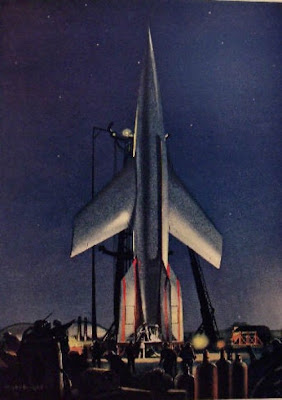Recently Michael Sporn and his friend Bill Peckmann put up a blog post about O. Wilson Link, the great railroad photographer of the 40s and 50s. I've long been a fan of Link's work, and it was nice to see him get some recognition on the internet.
http://www.michaelspornanimation.com/splog/
It was Link's book that made me realize that dramatic Hollywood-style lighting could transform the urban night time landscape. It could make the night more fun to inhabit.
Of course I'm not talking about making night into day. That would be too expensive, and would probably look terrible. I'm talking about selected targets that are near existing nightspots. And I'm talking about dramatic lighting, the kind of thing you see in Film Noir movies.
I like the way night light transforms things. The locomotive above may have looked unimpressive in the day, but at night it appears to be a cyclops emerging from the smoke, maybe to scratch its back on the railroad office. The right kind of dramatic lighting could lead to whole new urban mythology.
The right kind of lighting could extend commercial hours and bring more business to a city. Paris is a good example. It's called "The City of Lights." It got that name in Louis XIV's time, when he ordered oil lamps to be put at all intersections in the city, especially in the shopping districts. The idea was to promote the novel idea of night time shopping, and to promote Paris as a tourist destination.
Louis's innovation was a big success, and was much imitated. It began to dawn on people that the city at night was potentially a thing of beauty and mystery. Night was no longer a nuisance to be endured. Thanks to Louis, it was a resource to be exploited.
And why not? Half our time on this planet is spent on the dark side of the Earth, staring up at outer space (above). We should celebrate the experience, not just tolerate it. Thanks to electric lighting, and the example of Film Noir (and Louis and Link) we have the ability to make the night come alive. We have the ability to be poets of the urban landscape.
You could argue that lighting shouldn't have to save the appearance of a bland building. Buildings should be built from scratch to look good at night. Balconies, iron fences, trees, tiered sidewalks, alleyways, recessed enclaves, stairs, railings: all cast interesting shadows. An architect should ask himself what combination of features will allow the building to appear differently at different times of day, and at different seasons (above). He should think about what silhouette value it'll have, and how it'll look at night.
Foggy towns have great tourist potential, provided the fog is helped along by the right lighting, and provided that there's night time cafes and restaurants. Towns like this might even even consider fog enhancers. And how about adding plants that thrive only in foggy areas?
Well, I guess its possible to overdo this. If it starts looking fake and contrived, then we've gone too far.
The space program would surely get more taxpayer support if the rockets were lit more dramatically at night. Come to think of it, our rocket exteriors should be designed by artists. No doubt they would be less efficient, but they'd look cool, and that would bring in taxpayer dollars.




















































